This 22° halo was seen on a thin snow layer which formed on a freshly frozen river from power plant induced precipitation and freezing mist. The dark area inside the 22° halo is prominent, indicating well developed solid crystals that scatter light only at halo angles.
The photo shows also broad horizontal segments of cyan and magenta in the outer areas of 22° halo. These segments seem to be very sensitive to the variations in the camera positioning, changing their position relative to the 22° halo and ground features, as shown by other photos taken by Peter Vancoillie.
I have no explanation to offer. The display was seen in Ghent, Belgium on 21 December 2007.

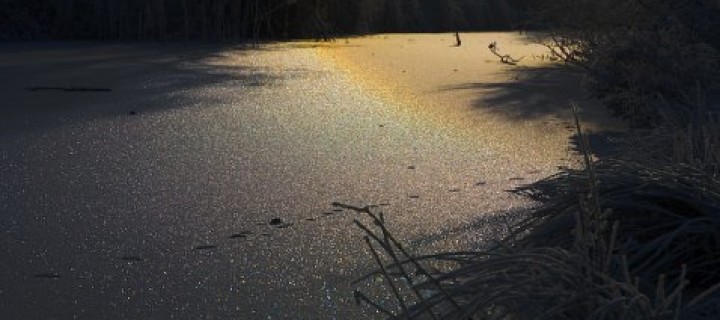
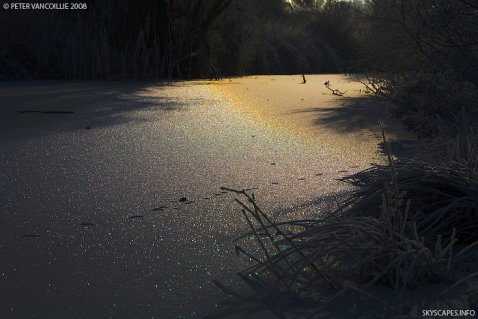
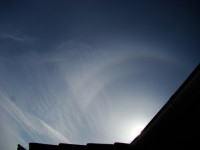
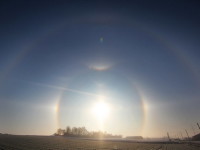
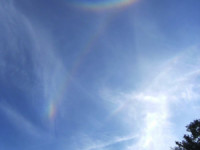
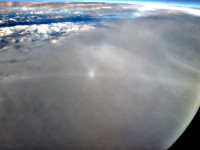
This repeated cyan and magenta similar to the diffraction spectrum (compare with iridescent cloud). So, may be there 2 effects: halo and difraction
Vladimir, first I’ve thought of the same, but what could have caused the diffraction?
well… this is frozen river. Water in river contain some sand, dust, silt. This sand can be contained in ice.
Or some fine dust might even fall on the frozen surface too (as the place is near some industry district, this is a real chance).
Hi everyone,
some extra info: the river basically is a big ditch in a nature/bird wildlife reserve near the city of Ghent. It does not contain streaming water, but it is definitely not really clear water either.
The ice layer on the water must have been about 5cm then.
Snow fell the evening and night before at subzero temperatures, mainly from mist, partly mixed with industrial watervapor exhaust and fine dust particles from traffic and industry, but the power plant, harbor and industry are about 5km and further away. The little wind that blew was coming from that direction though. Snowflakes were really tiny.
Apart from that there was a dense mist all night, so there sure was hoar frost on top of the thin (about 0,5 – 1cm) snow cover.
You can see on this google map where I took the picture:
http://maps.google.be/maps?f=q&hl=nl&geocode=12577278775626580232,51.062570,3.685980&q=Noormanstraat+%4051.062570,+3.685980&sll=51.074841,3.732948&sspn=0.103757,0.32135&ie=UTF8&ll=51.0839,3.752518&spn=0.103737,0.32135&z=12&om=1
You can see the point where the pictures were taken (if you zoom in, you’ll see the straight canal inside the green zone along which the pictures were taken), to the SE the city of Ghent, to the E and NE the harbor and industry.
Peter, thanks for the detailed info!
Have you taken any close-up photo of the surface? Or have you seen the size, shape of the hoarfrost on it?
No, sorry Noli. I have none of that. The ice wasn’t strong enough to stand on it, especially near the edges, otherwise I would have tried it with the macro extender rings I have.
I noticed the googlemaps link broke up and went out of the blogframe. Sorry for that. Copy and paste “Noormanstraat, Gent, Belgium” in googlemaps to see the map.
Aren’t those colors from separate crystals on snow surface? This wouldn’t favour the diffraction explanation.
The ice surface is covered with snow layer, it shouldn’t have anything to do with the phenomenon.
The colors change their position in a strange way, and as Peter noted me in email, in the zoomed uppermost image they are also narrower. This all just does not make sense.
I am bound to vote for image processing artefact.
As for me, there’s one more thing that I cannot understand. If it’s diffraction, why don’t the colours continue inside the halo, too?
Hi Marko and anyone who wants to check for image processing artefacts, I’ve provided the original RAW files (Canon 5D CR2 files). XMP with the settings I use are provided also if you want to see how I edited the pics (curves, etc). Read in ACR 4.2 or Lightroom.
It could still be a camera rendering artefact, sensor coating, colour patterns because of diodes or whatever? In that case, the raw files will not help much.
Please respect my work and do not use the RAW files for any other purpose!
link to the files: (add http://)
users.telenet.be/superpete/temp
Well, Peter, Thanks for showing the RAW files.
I do see all the features of the processed images on them too. And tried to find something that makes me quite sure that you have photographed some optical phenomena: the colors are very faint in the shadows of the tree branches, and where the branches are close to the ground level, colors cannot be seen at all. For me it justifies that the phenomena is a phenomena not an artefact.
Maybe not the snowflakes, but the much smaller and finer hoarfrost cristals that used to face one mostly direction could help creating this colors.
I feel sure that we will find out somehow what caused your “stripes”. You might have photographed something we still don’t understand, don’t even know, maybe something new – or maybe not.
Time will tell. But no matter what would be the answer, the pics are great and interesting and strange, they make us think about them, so I do like them. 🙂
Hi Noli,
I’m afraid I’ll have to disappoint you. I’m waiting for Jari’s report here on his RAW conversion tests which he will (should) publish here. They show that the coloured bands are really a software artefact. The Adobe Raw conversion engine seems to create them. He developed the raw files with Canon DPP to 16 bit TIFF files and was able to create JPEG’s without the coloured bands, but the previews showed them as well. So most probably and unfortunately this is not a halo puzzle, but a rendering puzzle. But off course it is still very interesting, since I’ve never seen anything like it with the ACR engine, which I use exclusively because of its speed and ease of use (Lightroom mostly, but for more precision I prefer the ACR plugin in Bridge). It should keep us aware that all this new technology is still in development and not a 100% reliable!
Good morning, Peter! So you (and your camera)have invented a new halo instead of discovering one! 🙂
But how couls you see them as noted on the linked page with more photoes: “The halo and bands were visible with the naked eye”?
Maybe your eye’s software also needs some more developement? 😉
Yes, I’ve started from that cited sentence, if you could see the colored bands, they must have been there.
Hi Noli, I know I wrote that, and I really believe I did see it. Self induced memories 😉 ? Thing is I took these photo’s on the 21st and because of Christmas etc and being ill, I didn’t look at them for more than 10 days. Then I started to look at them and process, and these bands showed up. Now what I probably confuse is that I saw a slightly darker band there, reducing the halo also, which seems to generate the colouring in the bands in ACR. That darkening I remember, but I wasn’t a 100% sure about the colouring, which I wrote in a mail to Marko earlier also. There was a lot to see that day (scenic landscapes like this only show up every few years here) and I must have mixed up what I remembered and what I saw on the pictures. Even now I would still say I saw them. I hope it doesn’t end with memories of being abducted by aliens :s
Well I could be funny about it, but I hope no one thinks this was done with bad intention. It’s not something I would do to make myself unpopular. It showed up in the pictures, and I believe I saw it and I couldn’t figure out what it was and in thinking it was an optic display, I started mailing it to everyone to find out. That’s it basically. I’m happy it’s solved now. I will adjust my webpage with the new findings and comments Friday or this weekend, and I’ll post it to anyone else I wrote to (meteoros and Les Cowley).
Peter, I’m not happy that you’ve lost a phenomena, but happy that you’ve not lost your sense of humor. 🙂
Ok so I finally updated my webpage with Jari’s raw conversion results from Canon Digital Photo Professional to 16 bit TIFF files, which don’t show the colouring bands.
I still feel like an idiot though for remembering seeing them. I’ll have to look more careful and maybe take notes in the future :s
http://skyscapes.info/2007-12-21_optics-puzzle_Mariakerke.html
Sorry for the delay in my response.
I made a few quick conversions with Canon’s own DPP software. I used the standard picture style, adjusted the blackpoint and brought the exposure down quite a bit in order to allow for easy analysis of the highlights. I also fiddled with contrast and saturation. I then converted the images into 16-bit aRGB Tiffs. (These were then resized and converted into sRGB for the web, saved as mildly compressed jpgs).
On my monitor I can see no colour bands in the DPP conversions. I also tried Canon’s RAW Image Task software with similar results.
However, the DPP preview thumbnails, which I reckon are generated with speed as priority, display a strong artefact colour band which cannot be seen in the actual converted tifs (or in the large RAW preview window).
Could the ACR conversion be somehow exhibiting something similar that is being seen in the DPP preview images?
My guess is that we’re dealing with differences between two RAW software packages in the way they handle and preserve the extreme highlights. They apparently do not share the exact same demosaicing algorithms.
With “normal” photographs the Adobe Camera RAW module is very popular due to it’s ability to preserve and retain nearly burned out highlights.
More testing should be carried out though and I might get back to this when time permits.
It would be very interesting to have more conversions with other RAW conversion software.